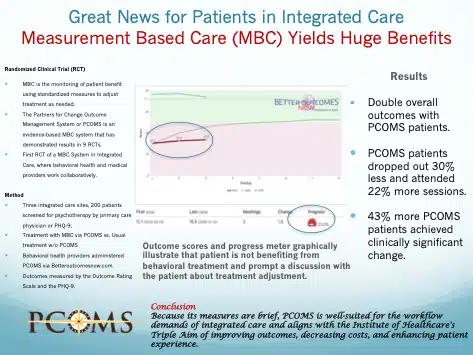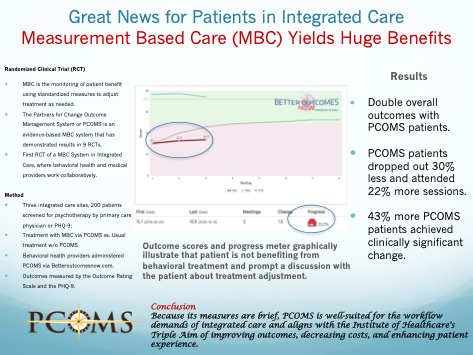Why You Should Implement Routine Outcome Monitoring in Behavioral Health

Routine outcome monitoring (ROM) is gaining traction across behavioral health settings. Not only has research demonstrated increased therapy outcomes and efficiency, all three major accreditation bodies now require client-generated outcome measurement.
The Partners for Change Outcome Management System (PCOMS) and its web application, Better Outcomes Now (BON), represent the only system that can say that it is both truly evidenced based and, because of its ultra-brief measures, feasible for the workload demands of everyday practice.
Truly Evidence-Based Routine Outcome Monitoring in Behavioral Health
While many ROM systems give lip service to being evidence based, a little deeper dig reveals that only 2 systems are. PCOMS is one of them and the most feasible for routine practice. There are now 9 randomized clinical trials that have demonstrated improved outcomes and reduced dropouts with PCOMS; 8 of the 9 were conducted by those affiliated with Better Outcomes Now. This body of work has shown that PCOMS improves outcomes in individual, couple, and group therapy, with children and adults, and with both mental health and addiction treatment.

The latest RCT, conducted in three integrated care sites, demonstrated that the benefits of PCOMS and BON are also realized in the workflow demands of integrated care. No other system can make such a claim. BON’s commitment to the scientific credibility of routine outcome monitoring in psychotherapy combined with the fact that Dr. Barry Duncan developed the clinical process of PCOMS combines to a more credible and feasible web system that replicates the spirit and intent of PCOMS.
Technology and Routine Outcome Monitoring in Mental Health Care
Advances in technology provide behavioral health organizations a much better avenue for ROM via collecting and disseminating outcome data. Practitioners now use smartphones, tablets, or other smart devices, and clients can even complete measures remotely. Nevertheless, neither the convenience that technology offers, nor the evidence that research provides, nor the requirements of accreditation bodies make implementation easy. The fact is that most do not take to ROM like a duck to water. Getting started with a measurement based care system requires some planning. Determining your organizational readiness for implementation is the first step. Dr. Barry L. Duncan, CEO of Better Outcomes Now and the leading expert in client feedback and routine outcome monitoring, has implemented PCOMS in hundreds of organizations across the globe. His collaborations with leaders in the public behavioral health field have resulted in the following five strategies.
Getting Started With Routine Outcome Monitoring
1. Find the “True Believers” – Identify the “PCOMS Champions.” Identify clinical champions who want to know their outcomes, and who value transparency, client directed services, and social justice. The best selections will be folks who are already seen as clinical champions, well respected by colleagues. It also helps if these PCOMS champions have a “get the job done” attitude. These champions help organizations generate and sustain momentum and will be equipped to resolve challenges along the way. They will create enthusiasm about collecting outcomes using a web-based system and will be a core component of your multidisciplinary team. Their enthusiasm for client welfare and social justice will be contagious.
2. Organize a Multidisciplinary Implementation Team. Sustainable outcomes measurement depends on the engagement of a broad range of roles and functions within the organization. The implementation team should represent the agency in total: i.e., directors, supervisors, administrators, quality improvement staff, support staff, grant writers, IT, and importantly, the clinical champions. This team meets at least monthly and presents to your quality improvement committee quarterly to update on the progress of implementation and strategize the next steps. These meetings help keep the team accountable and ensure buy-in and involvement from all key departments and decision-makers.
3. Invest Time and Resources. Although measurement-based care or ROM is critical to long-term agency success, it’s a long-term investment that won’t pay off immediately! Dr. Duncan has often referred to this as “being in it for the long haul.” This requires that the CEO, CFO, and Clinical Director provide the tools and resources needed for implementation to be successful. When all levels of leadership see the value of measuring outcomes as the organization’s best approach for achieving both its clinical and financial aims, PCOMS is more likely to take hold and develop. Check out the secrets of implementation.
The investment includes helping your champions become confident in PCOMS and their abilities to train staff. Strive to make your implementation team, as many as budget allows, experts in PCOMS by having them attend the PCOMS Training of Trainers Conference. Implementation can go off track when leaders do not feel confident to address the myriad of issues that will arise during implementation. Include a succession plan if and when a champion leaves. Have folks in mind who will step in. Investment also includes technology, both hardware, and software.
Our BON public behavioral health leaders have been successful in securing funding for the training, hardware, and software to implement BON. Routine outcome monitoring and measure based care are included in their annual budget as a line item under but not limited to general operating expenses, training, and technology.
4. Use Early Successes to Spread Implementation. Clinicians respond to inspiration from their colleagues, so share success stories to activate interest throughout the organization. In the initial implementation stages, it is best to focus on areas or programs with high potential for success. For example, start with individual outpatient therapy and gradually add services with multiple individuals and/or practitioners. Start small and consider a pilot to ensure early success. With all the demands placed on practitioners, it is important to help them see the value that measuring client benefit can bring to their work. Inspiring them to use the data to develop professionally and get better at what they do one client at a time can keep them engaged. Seeing colleagues in other programs singing the praises prepares the newly implementing providers for the benefits that lie ahead. Successes in implementation should also be communicated to funders, the Board of Directors, administrative leaders, and support staff. Everyone can share in delivering services that are consumer-driven, socially just, and effective.
Provide opportunities for sharing and celebrating success. Plan to block out time for front-line clinicians and supervisors to attend or complete online training, and then discuss what they have learned. For example, setting aside time in group supervision or in clinical staff meetings to read and discuss a chapter from the PCOMS Manual will result in increased fidelity of implementation, as well as an opportunity to ask for success stories.
5. Celebrate Success Along the Way to Build an Agency Culture of Feedback. Implementing ROM takes time. Remember we are “in it for the long haul and it is not for the faint of heart.” It is important to celebrate success along the way to keep practitioners engaged and maintain momentum. Be creative in your recognition of successes while being careful not to have anyone individual or department being left out. Small successes in one area can be successes for all. Front line folks are more likely to continue to develop in their implementation when leadership can recognize and celebrate their efforts. This spreads enthusiasm among believers who are often your greatest resource in converting nay-sayers. Converts are especially helpful, especially if they are well-respected clinicians.
Finally, these small incremental successes will ultimately build an agency culture of feedback, a culture that values the collection and dissemination of client generated data. This can only be accomplished when folks at all levels in the organization understand what the data truly means: namely, the representation of client voice and privilege in the therapy dyad and beyond.
Don’t be discouraged by false starts and be prepared to hit the reset button or seek consultation from leading experts in the BON network.
